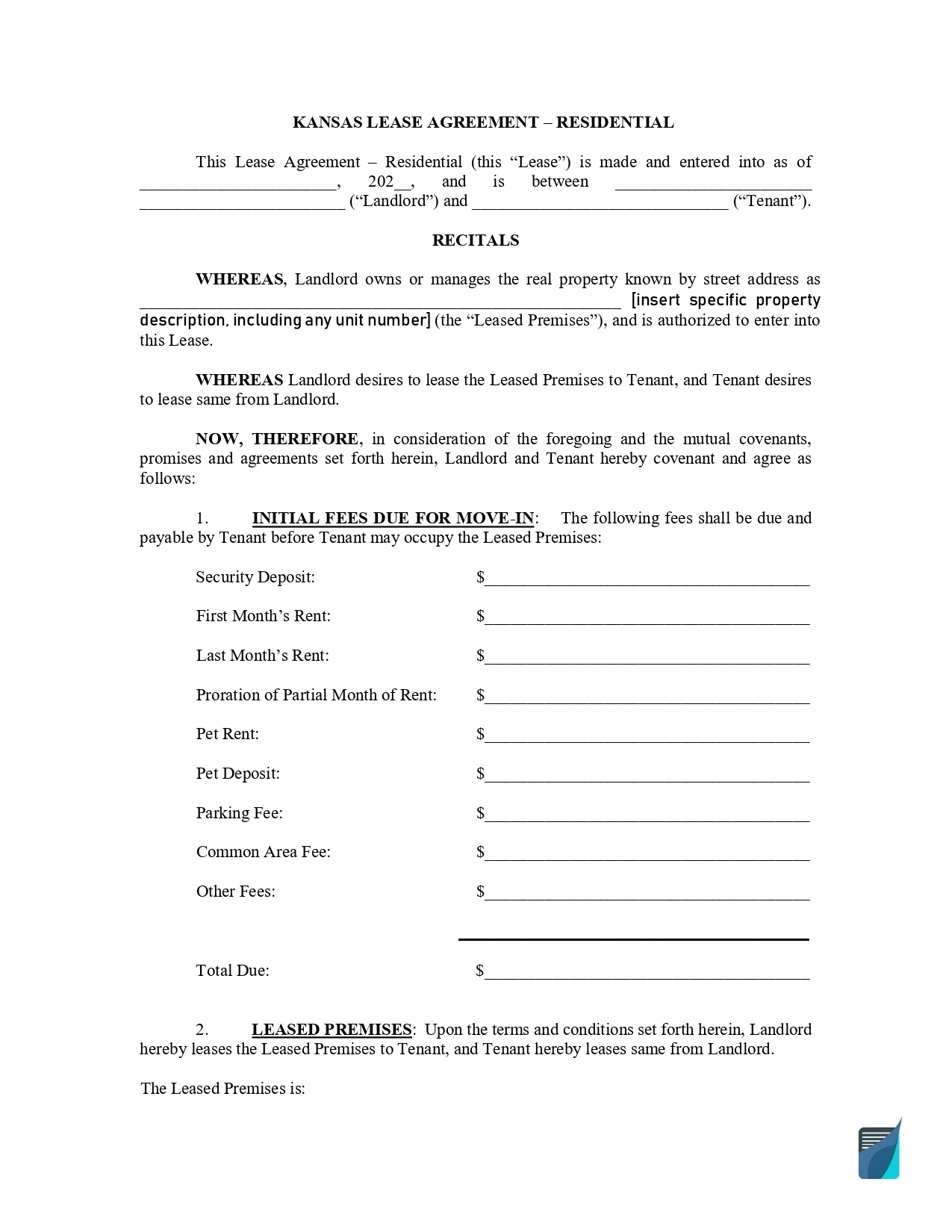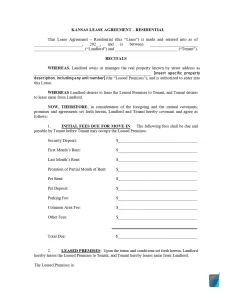Kansas Rental Lease Agreement Forms
The Kansas rental lease agreement is a legally binding contract between a landlord and a tenant that outlines the terms under which the tenant can rent property. This agreement specifies details such as the duration of the lease, typically a set period like one year or month-to-month, and the specified rent amount. The Kansas lease agreement also covers regulations for property use, any limitations, tasks for maintenance, and how repairs will be handled.
Using proper rental lease agreement forms is very important. They help clarify the relationship between the landlord and tenant and spell out what each can and cannot do.

Build Your Document
Answer a few simple questions to make your document in minutes
Save and Print
Save progress and finish on any device, download and print anytime
Sign and Use
Your valid, lawyer-approved document is ready
Kansas Laws and Lease Requirements
Kansas Statutes, Chapter 58, Article 25 (Landlords and Tenants) encompasses all pertinent laws related to rental property agreements.
Security Deposits in Kansas
Under Kansas Statutes, Section 58-2550, landlords can request a security deposit of up to one month’s rent for an unfurnished dwelling. If the dwelling includes furniture, this amount can increase to 1.5 months’ rent. If tenants have pets, landlords can collect an extra deposit not exceeding half a month’s rent. These limits help prevent excessive demands and ensure that the deposits correspond to potential liabilities like damages from furniture or pets.
When a lease ends, the security deposit must be returned within 30 days, as stipulated by the same statute. If there are deductions for necessary repairs, the landlord must itemize these and return the remaining deposit within 14 days after the deductions are finalized. Should the tenant fail to provide a new address, the landlord must send the remaining deposit to the tenant’s last known address within the same 30-day period.
Owner’s Access
The right of a landlord to enter a rental unit is specified under Section 58-2557 of the Kansas Statutes. Landlords can enter a tenant’s dwelling at reasonable hours and with reasonable notice for several purposes. These include inspection of the premises, conducting necessary or agreed-upon repairs or improvements, providing necessary services, or showing the property to potential buyers or renters.
However, strict limitations ensure this right is not misused. Entry without the tenant’s consent is only permissible in urgent situations where there is a risk of severe harm to life or significant property damage. Importantly, landlords are prohibited from abusing this access right to harass tenants, ensuring respect for the tenant’s privacy and peace.
Needed Disclosures
Landlords in Kansas must make several mandatory disclosures to ensure transparency at the inception of a tenancy:
- Owner identity disclosure. Per Section 58-2551, landlords must disclose the identity and address of the property’s owner or any managing agents at the beginning of the leasing process.
- Move-in checklist requirement. Additionally, Kansas Statutes, Section 58-2548, requires the landlord and tenant to complete a move-in checklist within the first five days of occupancy.
- Lead-based paint warning. Federal regulations under 42 U.S. Code § 4852d mandate that tenants be informed about potential lead-based paint hazards for any property built before 1978.
The statutory requirements in Kansas establish a transparent and legally compliant rental environment, ensuring that landlords and tenants are aware of and follow their rights and duties.
Common Types of Lease Agreements in Kansas
In Kansas, there are several rental agreements to suit different situations:
- Fixed-term lease. This agreement specifies a set duration, commonly one year, offering stability and a fixed rental income. It ends automatically unless renewed.
- Month-to-month rental agreement. This flexible arrangement continues indefinitely monthly until either party typically gives 30 days’ notice, which is ideal for tenants seeking short-term housing.
- Sublease agreement. This option allows the original tenant to rent the property to another tenant with the landlord’s approval, maintaining responsibility for rent and property condition.
- Room rental agreement. This is common in shared housing. It involves renting out individual rooms, with tenants sharing common areas.
- Lease-to-own agreements. In these, a portion of the rent goes towards a future property purchase, ideal for tenants planning to buy.
All of these agreements follow the laws of the state of Kansas, which helps protect everyone involved.
Kansas Rental Lease Agreement Form Details
| Document Name | Kansas Rental Lease Agreement Form |
| Other Names | KS Rental Lease, Kansas Residential Lease Agreement |
| Relevant Laws | Kansas Statutes, Chapter 58, Article 25 |
| Security Deposit Amount | One (1) month’s rent (unfurnished) or one and a half ( 1,5) months’ rent (furnished) |
| Security Deposit Return | Thirty (30) days after termination of the tenancy |
| Avg. Time to Fill Out | 18 minutes |
| # of Fillable Fields | 119 |
| Available Formats | Adobe PDF |


We provide a wide range of important Kansas documents to anyone in quest of convenience when handling various agreements, contracts, and other paperwork in the state.
Other Rental Lease Agreement Forms by State